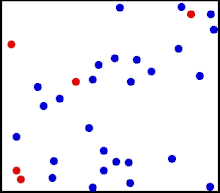File:Translational motion gif with ffmpeg2theora 024.ogv
Translational_motion_gif_with_ffmpeg2theora_024.ogv (Ogg Theora video file, length 19 s, 300 × 264 pixels, 173 kbps, file size: 392 KB)
Captions
Captions
Summary[edit]
| DescriptionTranslational motion gif with ffmpeg2theora 024.ogv |
Motion of gas molecules Español: Animación mostrando la agitación térmica de un gas. Cinco partículas han sido coloreadas de rojo para facilitar el seguimiento de sus movimientos.
Русский: Хаотическое тепловое движение на плоскости частиц газа таких как атомы и молекулы |
| Date | (original) 2010-04-28 (converted to OGV) |
| Source |
This file was derived from: Translational motion.gif English: Converted as follows:
|
| Author | A.Greg, en:User:Greg L |
| Other versions |
 |
Translational motions—the randomized thermal vibrations of fundamental particles such as atoms and molecules—gives a substance its “kinetic temperature.” Here, the size of helium atoms relative to their spacing is shown to scale under 1950 atmospheres of pressure. These room-temperature atoms have a certain, average speed (slowed down here two trillion fold). At any given instant however, a particular helium atom may be moving much faster than average while another may be nearly motionless. The rebound kinetics of elastic collisions are accurately modeled here. If the velocities over time are plotted on a histogram, a Maxwell-Boltzmann distribution curve will be generated. Five atoms are colored red to facilitate following their motions.
Note that whereas the relative size, spacing, and scaled velocity of the atoms shown here accurately represent room-temperature helium atoms at a pressure of 1950 atmospheres, this is a two-dimensional scientific model; the atoms of gases in the real world aren’t constrained to moving in two dimensions in windows precisely one atom thick. If reality worked like this animation, there would be zero pressure on the two faces of the box bounding the Z-axis. The value of 1950 atmospheres is that which would be achieved if room-temperature helium atoms had the same inter-atomic separation in 3-D as they have in this 2-D animation.
Licensing[edit]
| Public domainPublic domainfalsefalse |
| This image of simple geometry is ineligible for copyright and therefore in the public domain, because it consists entirely of information that is common property and contains no original authorship. |  |
File history
Click on a date/time to view the file as it appeared at that time.
| Date/Time | Thumbnail | Dimensions | User | Comment | |
|---|---|---|---|---|---|
| current | 20:35, 28 April 2010 | 19 s, 300 × 264 (392 KB) | 84user (talk | contribs) | == {{int:filedesc}} == {{Information |Description=Motion of gas molecules {{es|Animación mostrando la agitación térmica de un gas. Cinco partículas han sido coloreadas de rojo para facilitar el seguimiento de sus movimientos.}} {{ru|Хаотическ |
You cannot overwrite this file.
File usage on Commons
The following 4 pages use this file:
Transcode status
Update transcode statusFile usage on other wikis
The following other wikis use this file:
- Usage on et.wikipedia.org
- Usage on fr.wikiversity.org
Metadata
This file contains additional information such as Exif metadata which may have been added by the digital camera, scanner, or software program used to create or digitize it. If the file has been modified from its original state, some details such as the timestamp may not fully reflect those of the original file. The timestamp is only as accurate as the clock in the camera, and it may be completely wrong.
| Software used |
|---|